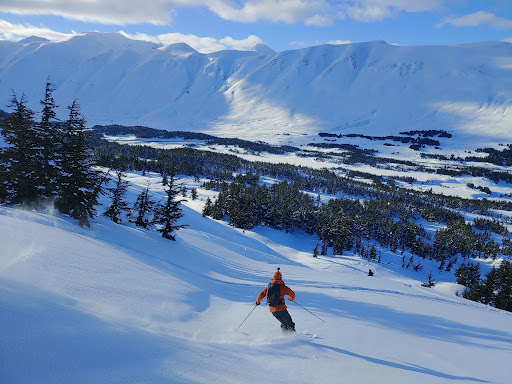
Alaska skiing with the Jetforce UL. Photo: Zach Runyan
Why doesn’t everyone ride with an avalanche airbag? Setting aside dependable points about risk homeostasis, my answer is threefold: they’re heavy, expensive, and often perform less well than their non-inflatable brethren.
The Black Diamond Jetforce UL is Black Diamond’s canister-based attempt to make the lightest bag they reasonably could (hence the “UL”, i.e. Ultra Light moniker) while keeping the cost reasonable and design functional. I’ve spent a season with the pack and formed thoughts about its performance for a first-time airbag user.
The Airbag Technology
The Jetforce UL uses compressed gas canisters rather than heavier batteries or supercapacitors to inflate its 150L airbag. BD’s engineers chose to use Alpride’s 2.0 canister system, the same inflation tech found in some G3 and Scott packs.
Alpride’s “airbag system 2.0” uses two pre-sealed canisters, one filled with argon, the other with carbon dioxide. These canisters are purchased online or from brick and mortar retailers and installed by the user. Unlike other canister-based systems (e.g. Mammut or BCA), these canisters are single use only. Once the canister’s foil seals are punctured, they’re useless, and need to be replaced with new ones.
Two pre-loaded pins spring forward when the user pulls the deployment handle, piercing foil seals on the gas canisters. Gas flowing out of the cylinders pulls in air from the outside environment, inflating a bag stored behind a birthing zipper running across the top and sides of the back. Once inflated, the airbag (hopefully) buoys the user above the avalanche flowing around them.
I won’t dwell on the debate surrounding the effectiveness of avalanche airbags here. I will state that, in my opinion, they significantly increase the chances of surviving certain classes of avalanches. Of course, they are never a substitute for a partner, avalanche gear, or decision making aimed at keeping you out of an avalanche in the first place.
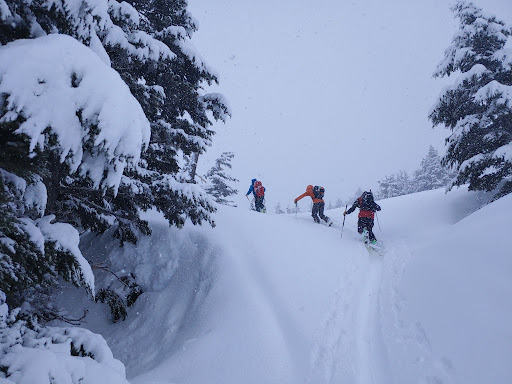
Storm days with friends. Left to right, the OG Jetforce (battery powered), the Jetforce UL (canister powered), and the Jetforce Tour (supercapacitor powered). Photo: Zach Runyan
The Bag Itself
The Jetforce UL sports a somewhat stripped down set of features. Although marketed towards the fast and light crowd, the pack includes a diagonal ski carry, an internal sleeve for avalanche equipment, an ice axe carry, a small internal mesh zippered compartment, a goggle pocket, and a helmet carry.
Notably, although this bag is not designed with hydration bladders in mind, I did manage to run a hydration tube down the non-trigger shoulder strap, allowing me to drink from an internal bladder. (On the Jetforce UL the trigger mounts on either the left or right shoulder strap, presumably to accommodate lefties and righties.) This is an “at your own risk” mod. But for what it’s worth, when I accidentally deployed the bag with a hydration tube attached to the non-trigger side shoulder strap, the airbag seemed to deploy fine.
Hoisting the bag, it’s immediately noticeable how light it is. Per the BD website, the bag weighs in at 1991 grams (including canisters), breaking the magical 2-kilogram barrier, putting it in the range of the lightest ski-specific airbags available. I’m somewhat of a gram weenie and was reluctant to buy an airbag after lifting friends’ BD Jetforce V1 and BCA packs – they immediately felt heavy. However, during the winter, I’ve never reached for a lighter pack (including on some 10K vert days), and never felt like I was sacrificing speed on the skin track to gain safety on the ski.
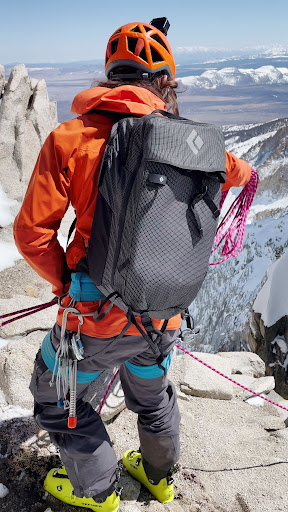
The Black Diamond Jetforce UL in action. Photo: Frits Van Paasschen
The bag is sold as a 26L pack and feels like it has roughly 18L of capacity with the airbag installed. Although you won’t be carrying overnight gear in the Jetforce UL, the pack is a sweet size for single-push ski mountaineering. I can fit water, a bit of food, an insulating layer, crampons, ascent plates, and standard avalanche gear in the pack without too much squeezing. I even fit a 60m rappel rope on several occasions. However, I do tend to choose small gear and am generally OK with being a bit spartan when packing.
With a few exceptions (see below), I enjoyed touring with this pack. The pack checked all the boxes I look for in terms of features, and was generally comfortable and functional. Most days, it did what any good piece of gear does: disappear into the background, letting you enjoy the skiing without worrying too much about what you’re wearing.
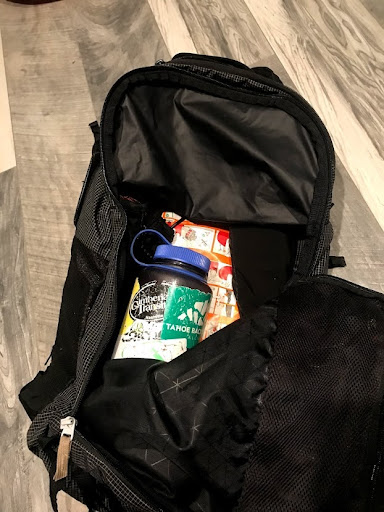
The unzipped Jetforce UL, with a 1L Nalgene for scale.
Air Travel
For whatever reason, the ability to fly with a pack seems to be a significant consideration for those buying an airbag (maybe those dropping close to a thousand dollars on a backpack tend to not mind ponying up for airfare?). Flyability was not my primary concern when shopping for bags, but I experienced flying with the Jetforce UL twice this season.
Traveling with the bag was doable, but not a joy. I packed the bag in my carry-on (in the hopes of talking to a TSA agent at security in case of issues, rather than having it simply confiscated out of a checked bag) and got through security each time hassle-free. Although Black Diamond claims that the canisters are acceptable to fly with (they’re the same design as the canisters which power the life vests under plane seats), reading the fine print on airline websites muddies the waters. I’m guessing you could get one onto a plane on some days, but it would take either a bit of luck or a good deal of experience sweet talking TSA agents.
I chose not to fly with the canisters and instead just had them delivered to an REI near my final destination. (Caveat emptor, while shipping in the lower 48 seemed to work fine, shipping canisters to Alaska was somewhat of a challenge.) After arrival, I picked up the canisters at REI, installed them in the bag, and went on my merry way.

The Black Diamond Jetforce UL in action. Photo: Frits Van Paasschen
Growing Pains?
While this is far from BD’s first airbag, it is their first that I would classify as ultralight. There are several features on the pack that strike me as workable, but remain far from perfect. It’s unclear if these are simply growing pains associated with a first-generation pack, or if designers cut corners to nudge the bag into the eye-popping 1900 gram range. To list a few of the problems I encountered:
– The waist strap is small and doesn’t help much with carrying (to be fair, you’re not going to be fitting huge loads in the pack anyway, given the capacity). The waist buckle is frankly tiny, and a bit hard to take on and off with gloves on.
– The ski carry is workable but leaves something to be desired, especially when the pack isn’t very full. The top attachment point isn’t directly attached to the shoulder strap, making the connection to your back a bit less secure and bomber when climbing with skis attached.
– The zipper for the internal pouch securing the inflation mechanism frequently opened. I have difficulty seeing how this would prevent the airbag from working correctly, but it’s annoying.
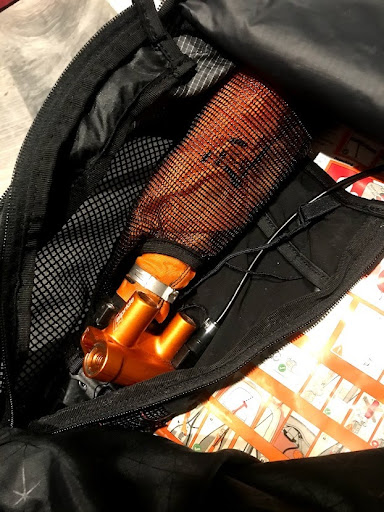
The Alpride inflation mechanism inside the unzipped pouch, sans canisters.
– Although the packed airbag provides a fair amount of structure, the pack lacks a rigid back panel. This makes packing less efficient, and the shoulder straps less comfortable, especially compared to the highly functional design used in the BD Dawn Patrol backpack line.
– In one somewhat violent crash, the airbag birthing zipper split open, spilling the bag, necessitating a field repacking.
– The canister installation/arming instructions were unclear. Despite excitedly reading the instructions several times, I still messed up, wasting an expensive canister set the first time I armed the bag. It turns out YOU MUST ARM THE BAG BEFORE INSTALLING THE CANISTERS, or you’ll puncture the canisters while loading the inflation pins.
– The materials, in general, felt a bit cheaper and less burley than in other packs I’ve handled. To be fair, I haven’t had any durability problems despite heavy use, but it doesn’t feel quite as good in the hand. Of course, these materials may account for some of the weight savings.
– The helmet carry system pocket has a poorly designed velcro closure, making it hard to securely close, especially when the bag is full. I wish BD used another 5 grams of higher quality velcro (or readjusted the size of the pocket) so the helmet carry didn’t open despite being closed with care.
While no pack is perfect, I’m a little disappointed this pack seems to have so many problems of this nature. To be clear, none of these is even close to a deal-breaker, but they do illustrate that this pack isn’t (yet) the platonic ideal of an ultralight airbag. I’m hoping Black Diamond releases a second generation of this pack which sings. The potential is there, but for now, the execution is just the slightest bit lacking.
The Bottom Line
Should you buy an avalanche airbag? Without a doubt, airbags are expensive but are comparable in cost to a pair of skis, boots, bindings, a ski pass, a set of avalanche gear, or an AIARE class. I want to ski steep winter snow and generally want to stack the odds of not dying in my favor if I make a flawed decision. To be sure, an airbag probably isn’t the first thing a beginner ski tourer should purchase and is probably overkill if you rarely ski in avalanche terrain or if you only tour in the late spring and summer. But for me, padding my margins of surviving a life of backcountry skiing just a little bit more in my favor is worth it.
Should you buy this avalanche airbag? If you’re someone like me, who would leave a heavy airbag in the car on most tours, but who also wants an extra margin of safety while skiing avalanche terrain in winter snow; In that case, the Black Diamond Jetforce UL is an excellent choice, possibly the best on the market. To be clear, there are some problems with the execution of this pack, and people who need a large pack, one which cheaply accommodates multiple pulls, or one with a ton of fancy features, may want to look elsewhere. That said, I have no qualms about having bought this pack, and wouldn’t hesitate to recommend it to others.
In terms of value, this bag is significantly cheaper than other electronic models on the market, especially if the Jetforce UL can be found on sale. It’s a bit more expensive than comparable Mammut or BCA models, but the small increase in cost can be justified in terms of weight savings and features.
Of course, it’s somewhat expensive compared to electronic models when comparing cost per inflation, but if you’re worried about the expense of having to inflate your airbag that much, I’d argue you should be re-calibrating your terrain selection. If you want to practice pulling the trigger, the Jetforce UL can be “dry-fired” with the system armed and without the cartridges installed.
The Black Diamond Jetforce UL is a great option for a light avalanche airbag, albeit with some room for improvement. Black Diamond, if you’re listening, could we please have a Jetforce UL V2?
Model Name: Black Diamond Jetforce UL 26L
MSRP: $849.95
Sizes: S/M, M/L
Claimed Weight: 1991 grams (M/L, with cartridges)
Capacity: 26L (M/L)
Roger Romani is a skier based in the California Bay Area. When not skiing in Tahoe, the Eastern Sierra, or the Cascades, Roger can be found in a UC Berkeley Physics lab, where he works as a graduate student building dark matter detectors. You can follow him on Instagram @roger_romani.
